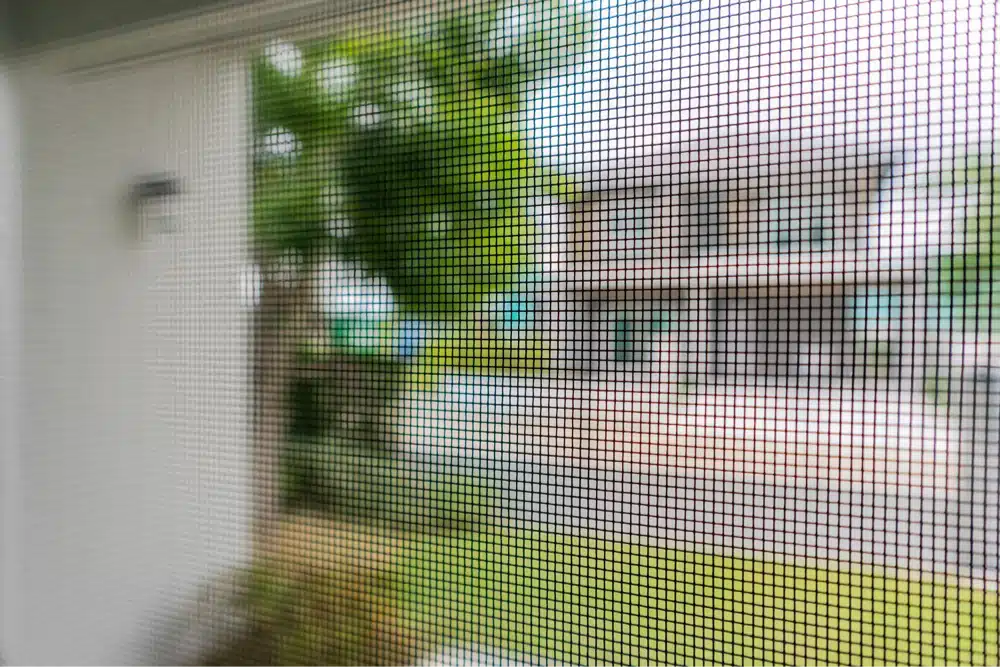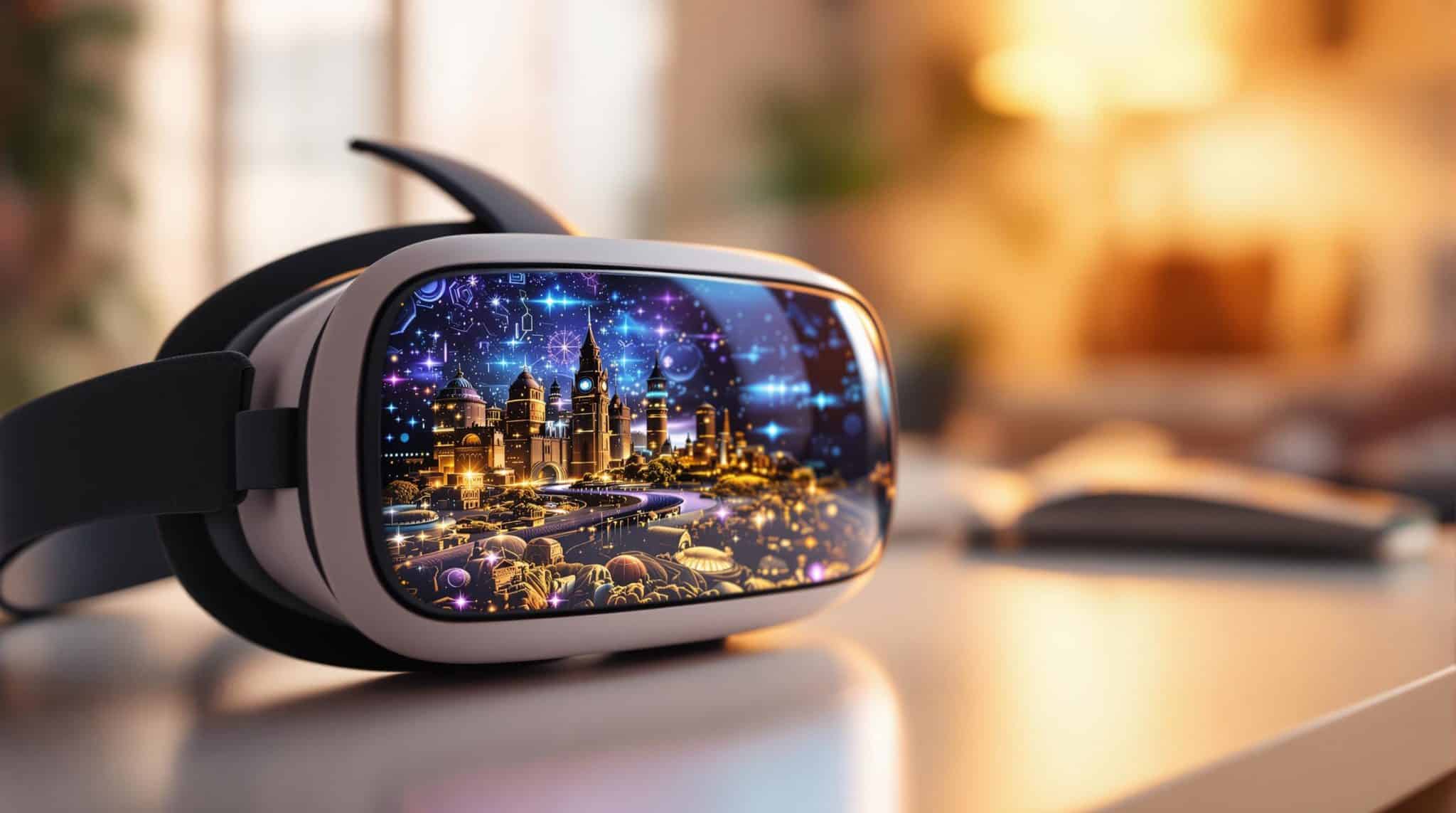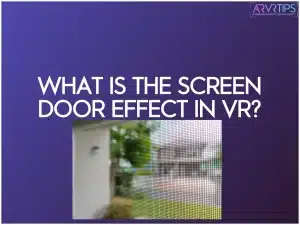The screen door effect (SDE) is a visual artifact in virtual reality (VR) where gaps between pixels create a grid-like pattern, resembling a screen door. This happens because VR displays are close to your eyes and magnified by lenses, making pixel gaps more noticeable, similar to the effect seen in digital projectors.
Quick Summary
The screen door effect resembles a mesh screen, which can impact the visual experience of users. Here’s what you need to know:
- Why It Matters: SDE disrupts immersion and can reduce clarity, especially in detailed visuals or text-heavy VR tasks.
- Causes: Low pixel density, display technology (e.g., OLED vs. LCD), and proximity to the screen amplify the effect.
- Impact: SDE affects immersion differently for each user, with sharper eyesight or prolonged use making it more noticeable.
- Solutions: Modern headsets like the Varjo Aero reduce SDE with high-resolution displays, better optics, and advanced technologies like Micro-LED.
To minimize the effect, focus on high-resolution headsets, adjust your VR settings for clarity, and choose rich, detailed VR content that draws attention away from pixel gaps.
Causes of the VR Screen Door Effect
The screen door effect in VR happens due to two main technical reasons.
Pixel Density and Resolution
This effect occurs when the pixel density isn’t high enough, making the visibility of individual pixels contribute to the screen door effect. These gaps create a mesh-like pattern that resembles looking through a screen door. The type of display technology also plays a role. For instance, OLED and Micro-LED displays often show this effect less prominently than LCDs because they have smaller gaps between pixels.
Take the Meta Quest as an example: even with its 773 PPI display, users can still notice the screen door effect. Different subpixel arrangements, such as PenTile and RGB stripe, can impact the visibility of the screen door effect by influencing color blending and resolution perception.
Proximity to the Display
In VR, the screen is placed very close to your eyes, and the headset lenses used to magnify the display also enlarge the gaps between pixels. This makes the effect more noticeable than on regular screens, similar to looking at pixels through a magnifying glass.
“The screen door effect is a visual perception by a person. By focusing attention on the content rather than the display itself, the screen door effect can become less noticeable”.
Additionally, the arrangement of subpixels, such as RGB stripe or PenTile layouts, can impact how visible the effect is. PenTile layouts, for example, sometimes make the gaps stand out more. This explains why two headsets with similar resolutions might show different levels of the screen door effect.
Recognizing these factors helps understand how the screen door effect influences the VR experience.

Impact of the Screen Door Effect on VR Experiences
Effect on Immersion and Clarity
The noticeable screen door effect (SDE) interrupts VR’s immersive feel by creating a visible grid-like pattern that can pull users out of the experience. Scenes with large blocks of solid color can make the screen door effect more noticeable, further detracting from immersion. This becomes especially distracting in scenarios involving high-contrast visuals or detailed textures, such as medical training simulations or architectural designs.
Tasks like reading text on virtual screens or using VR productivity tools are particularly affected, as the gaps between pixels reduce text sharpness and make it harder to focus.
Variations in User Perception
Not everyone experiences the screen door effect in the same way. Factors like visual acuity (those with sharper eyesight may notice it more), viewing distance, personal sensitivity, and the type of content being viewed all play a role. Prolonged exposure to these pixel gaps can contribute to eye strain and fatigue, especially during longer VR sessions.
In VR content with simpler graphics or larger objects, the effect tends to be less noticeable and bothersome [2]. However, in professional settings where users spend extended time in VR, the strain caused by the screen door effect can hurt both comfort and productivity.
Tackling the challenges posed by the screen door effect is crucial for improving VR experiences. Better display technology can help reduce or eliminate this issue, leading to smoother and more engaging virtual environments for users.

How to Reduce the Screen Door Effect in Virtual Reality
Higher Resolution Displays
High-resolution displays, such as those found in the Varjo Aero and Pimax Crystal, tackle the screen door effect by boosting pixel density.
Micro lenses can help correct for pixel gaps that may be perceptible when images are projected, thereby enhancing the overall quality of the image perceived by the viewer. This reduces the visible gaps between pixels, delivering smoother visuals and a more immersive experience.
While raising resolution is a key approach, manufacturers are also exploring other methods to address this issue.
Pixel Diffusion Methods
Pixel diffusion techniques, like optical diffusers or specialized pixel layouts (e.g., diamond configurations), help blur the gaps between pixels without compromising image clarity. These approaches evenly spread light across the display, leading to a more seamless viewing experience.
Alongside these methods, new display technologies are being developed to further minimize or eliminate the screen door effect.
Future Display Technology
Micro-LED displays are emerging as a strong contender for the next generation of VR headsets. Advancements in mixed reality technology, like the Samsung HMD Odyssey+, address the screen door effect with features such as an ‘anti-SDE AMOLED display.’ They offer the potential for extremely high pixel densities while maintaining impressive brightness and contrast.
Additionally, advanced optical systems are being designed to improve light management and refine pixel arrangements, offering exciting possibilities for future VR devices.
Despite their potential, technologies like Micro-LED displays and advanced optics face high production costs and manufacturing complexity, limiting their availability in mass-market VR headsets.
However, these advancements are a step toward achieving lifelike visuals in VR, enhancing the overall experience for users in various applications.
Tips for Minimizing the Screen Door Effect
Focus on VR Content
The screen door effect is less noticeable when users dive into visually detailed VR content. Playing games with higher graphical detail can make this effect less noticeable, as it encourages users to engage with the game’s visuals rather than the technical flaws of the headset. Games and apps with rich environments and complex graphics naturally shift attention away from pixel gaps, creating a more immersive visual experience.
Adjusting your headset properly also plays a big role in reducing the screen door effect. Ensure the interpupillary distance (IPD) is set correctly and position the headset for the best fit. These adjustments can help minimize visual distractions and improve overall clarity.
Selecting the Right VR Headset
Modern VR headsets tackle the screen door effect with advanced display technologies. The Quest Pro, for instance, offers a high resolution and unique subpixel arrangement that significantly reduces the visibility of the screen door effect compared to other headsets. When shopping for a headset, look for these features:
- High pixel density displays
- Sophisticated optical systems
- Optimized pixel layouts
- Displays like OLED or Micro-LED
Remember that different displays and pixel setups can impact how noticeable the screen door effect is, especially in bright or dark scenes. Test headsets with various types of content to find the one that works best for your needs.
Conclusion
Summary of Key Points
Thanks to improvements in pixel density and optical systems, the screen door effect has become much less noticeable. Advances in display resolution, pixel layouts, and optics have significantly reshaped the VR experience.
Key factors driving better visual quality in VR include:
- Improved rendering techniques that fully utilize display capabilities
- Software updates that boost visual sharpness
- Enhanced optical systems that refine how visuals are perceived
While these advancements have greatly reduced the screen door effect, future innovations aim to eliminate it.
Future of VR Display Quality
With higher resolutions and better pixel diffusion already making strides, upcoming technologies are set to tackle VR’s last remaining visual challenges. Manufacturers are focusing on cutting-edge displays like micro-LED and OLED, which are expected to deliver even higher pixel densities.
The next steps for VR hardware include:
- Further increasing display resolution and pixel density
- Refining pixel diffusion methods
- Developing advanced optical systems for sharper visuals
These efforts aim to completely remove the screen door effect, creating truly lifelike visuals. Such advancements will push VR closer to delivering an indistinguishable immersion from reality.
Freuqently Asked Questions About the VR Screen Door Effect (FAQs)
What is the screen door effect in VR?
The screen door effect (SDE) is a visual artifact in which gaps between pixels form a grid-like pattern on VR displays, resembling the mesh screens found in actual screen doors. This happens because the screens are very close to the eyes and magnified by lenses.
Is the screen door effect present on Meta Quest?
Modern headsets like the Meta Quest have significantly reduced the screen door effect by using higher resolutions and better optics.
Why does the screen door effect occur in virtual reality?
The screen door effect happens due to the small gaps between pixels in VR displays. These gaps become more apparent because VR headsets require close viewing distance.
Which VR headset minimizes the screen door effect the most?
Premium headsets like the Varjo Aero and Pimax Crystal reduce SDE to a minimal level with extremely high resolutions (e.g., Varjo’s 2,880 x 2,720 pixels per eye) and advanced display technologies.
Does the screen door effect still exist in VR?
Although modern VR headsets have made great strides in reducing SDE with higher pixel densities and advanced displays, the effect can still vary between headsets and may be perceived differently by each user.


